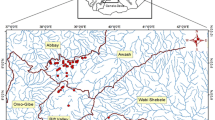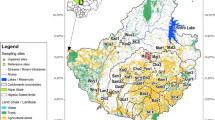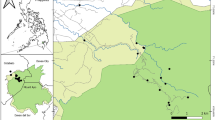Abstract
This study describes the application of a protocol for biological assessment of water quality at first to third order streams at Serra dos Órgãos, an area covered by Atlantic Forest in Rio de Janeiro State, Brazil. Major impacts in the region are domestic effluents and deforestation. Our main objective is to establish biocriteria for the establishment of the Serra dos Órgãos Multimetric Index (SOMI) based on benthic macroinvertebrates. We used data from previous studies, sampled by experienced biologists, from 1999 through 2002. The benthic macroinvertebrate community was sampled in 12 reference sites and seven impaired sites in three river basins: Guapimirim, Macaé and Grande, all from the same bioregion. From the 22 tested metrics, 6 were included in the SOMI (% Diptera, % Coleoptera, Family Taxa, EPT Taxa, BMWP-CETEC and % Shredders). Scores (5, 3 or 1) were developed for these metrics to allow for aggregation into the index. Seven intermediately impaired sites were used for evaluating the applicability of the multimetric index. We concluded that the SOMI is a robust easy-to-apply tool for biomonitoring programs in the Serra dos Órgãos region, south-east Brazil.




Similar content being viewed by others
References
Angrisano, E. B., 1995. Insecta Trichoptera. In Lopreto, E. C. & G. Tell (eds), Ecosistemas de Aguas Continentales. Metodologias para su estudio (vol III). Ediciones Sur, La Plata, 1199–1237.
Araújo, A. H., 2004. Estudo das comunidades de Trichoptera (Insecta) em riachos de quatro áreas de Mata Atlântica do estado do Rio de Janeiro. Tese de doutorado. Departamento de Ecologia, Universidade do Brasil (UFRJ). Rio de Janeiro-RJ, 104 pp.
Araújo, P. R. P., G. Friedrich & E. Coring, 1998. Use of artificial substrates for biological monitoring in the Guandu and Paraíba do Sul, Rio de Janeiro state, Brazil. Verhandlungen der internationalen Vereinigung für Limnologie 26: 1257–1259.
Armitage, P. D., D. Moss, J. F. Wright & M. T. Furse, 1983. The performance of a new biological water quality score system based on macroinvertebrates over a wide range of unpolluted running-water sites. Water Research 17: 333–347.
Baptista, D. F., L. F. M. Dorvillé, D. F. Buss & J. L. Nessimian, 2001. Spatial and temporal organization of aquatic insects assemblages in the longitudinal gradient of a tropical river. Brazilian Journal of Biology 61(2): 295–304.
Barbee, N. C., 2005. Grazing insects reduce algal biomass in a neotropical stream. Hydrobiologia 532: 153–165.
Barbour, M. T., J. B. Stribling & J. R. Karr, 1995. The multimetric approach for establishing biocriteria and measuring biological condition. In Davis, W. & T. Simon (eds), Biological Assessment and Criteria: Tools for Water Resource Planning and Decision-making. Lewis Publishers. Ann Arbor, Michigan: 63–76.
Barbour, M. T., J. Gerritsen, G. E. Griffith, R. Frydenbourg, E. McCarron, J. S. White & M. L. Bastian, 1996. A framework for biological criteria for Florida streams using benthic macroinvertbrates. Journal of the North American Benthological Society 15: 185–211.
Barbour, M. T., J. Gerritsen, B. D. Snyder & J. B. Stribling, 1999. Rapid Bioassessment Protocols for Use in Streams and Wadeable Rivers: Periphyton, Benthic Macroinvertebrates, and Fish. Second Edition. EPA 841-B-99-002. U.S. Environmental Protection Agency; Office of Water; Washington, D.C. Available at: http://www.epa.gov/owow/monitoring/rbp/. Last Access: November, 2005.
Böhmer, J., C. Rawer-Jost & A. Zenker, 2004. Multimetric assessment of data provided by water managers from Germany: assessment of several different types of stressors with macrozoobenthos communities. Hydrobiologia 516: 215–228.
Bryan, R. & J. Wilhm, 1990. Species diversity of benthic macro-invertebrates in Salt Creek, Oklahoma. Proceedings of the Oklahoma Academy of Science 70: 9–12.
Buffagni, A., S. Erba, M. Cazzola & L. L. Kemp, 2004. The AQEM multimetric system for the southern Italian Alpennines: assessing the impact of water quality and habitat degradation on pool macroinvertebrates in Mediterranean rivers. Hydrobiologia 516: 313–329.
Buss, D. F., 2001. Utilizando Macroinvertebrados no Desenvolvimento de um Procedimento Integrado de Avaliação da Qualidade da Água de Rios. Dissertação de Mestrado, Rio de Janeiro: Programa de Pós-Graduação em Ecologia, Universidade Federal do Rio de Janeiro.
Buss, D. F., D. F. Baptista, M. P. Silveira, J. L. Nessimian & L. F. M. Dorvillé, 2002. Influence of water chemistry and environmental degradation on macroinvertebrate assemblages in a river basin in south-east Brazil. Hydrobiolgia 481: 125–136.
Buss, D. F., D. F. Baptista & J. L. Nessimian, 2003 Conceptual basis for the application of biomonitoring on stream water quality programs. Cadernos de Saúde Pública 19(2): 465–473.
Clarke R. T., J. F. Wright & M. T. Furse, 2003. RIVPACS models for predicting the expected macroinvertebrate fauna and assessing the ecological quality of rivers. Ecological Modelling 160: 219–233.
Davis, W. S., B. D. Snyder, J. B. Stribling & C. Stoughton, 1996. Summary of State Biological Assessment Programs for Streams and Rivers. U.S. Environmental Protection Agency, Office of Planning, Policy, and Evaluation, Washington, D.C. EPA 230-R-96-007.
De Marmels, J., 1990. Key to the ultimate instar larvae of the Venezuelan odonate families. Opuscula Zoologica Fluminensis 50: 1–6.
DeShon, J. E., 1995. Development and application of the invertebrate community index (ICI). In Davis, W. S. & T. P. Simon (eds), Biological Assessment and Decision Making. Lewis Publishers, Boca Raton, Florida, 217–243.
Dominguez, E., M. D. Hubbard & W. D. Peters, 1992. Clave para ninfas y adultos de las familias y generos de Ephemeroptera Sudamericanos. Biol. Acuat. 16: 5–39.
Dorvillé, L. F. M. & C. G. Froehlich, 1999. Additional characters to distinguish the nymphs of the Perlidae genera from Southeastern Brazil (Insecta, Plecoptera). Aquatic Insects 21: 281–284.
Egler, M, 2002. Utilizando a fauna de macroinvertebrados como indicadores da integridade ambiental em uma área de agricultura intensiva em Nova Friburgo. Dissertação de Mestrado. Escola Nacional de Saúde Pública, Fundação Oswaldo Cruz. Rio de Janeiro, RJ, 103 pp.
European Commission, 2000. Directive 2000/60/EC of the European Parlament and Council, establishing a framework for Community action in the field of water policy. Official Journal of the European Community L327: 1–72.
Fore, L. S., J. R. Karr & R. W. Wisseman, 1996. Assessing invertebrate responses to human activities: evaluating alternative approaches. Journal of the North American Benthological Society 15(2): 212–231.
Froehlich, C. G., 1984. Brazilian Plecoptera 4. Nymphs of perlid genera from southeastern Brazil. Annales de Limnologie 20: 43–48.
Gerritsen, J., 1995. Additive biological indices for resource management. Journal of the North American Benthological Society 14: 451–457.
Ghetti, P. F., 1997. Indice Biotico Esteso (I.B.E). I Macroinvertebrati nel Controllo della Qualitá degli Ambienti di Acque Correnti. Provincia Autonoma di Trento, 222 pp.
Gibson, Jr., G. R., M. T. Barbour, J. B. Stribling, J. Gerritsen & J. R. Karr, 1996. Biological Criteria. Technical Guidance for Streams and Small Rivers. EPA/822-B-96-001. U.S. Environmental Protection Agency. Office of Science and Technology, Washington, DC.
Hering, D., O. Moog, L. Sandin & P. F. M. Verdonschot, 2004. Overview and application of the AQEM assessment system. Hydrobiologia 516: 1–20.
Hilsenhoff, W. L., 1987. An improved biotic index of organic stream pollution. Great Lakes Entomology 20: 31–39.
Hilsenhoff, W. L., 1988. Rapid field assessment of organic pollution with a family-level biotic index. Journal of the North American Benthological Society 7(1): 65–68.
Junqueira, V. M. & S. C. M. Campo, 1998. Adaptation of the BMWP for water quality evaluation to Rio das Velhas watershed (Minas Gerais, Brazil). Acta Limnologica Brasiliense 10(2): 125–135.
Junqueira, M. V., M. C. Amarante, C. F. S. Dias & E. S. Franca, 2000. Biomonitoramento da qualidade das águas da bacia do Alto Rio das Velhas (MG/Brasil) através de macroinvertebrados. Acta Limnologica Brasiliense 12(1): 73–87.
Karr, J. R., 1991. Biological integrity: a long-neglected aspect of water resource management. Ecological Applications 1: 66–84.
Karr, J. R., K. D. Fausch, P. L. Angermier, P. R. Yant & I. J. Schlosser, 1986. Assessing biological integrity in running waters: a method and its rationale. Illinois Natural History Survey, Special Publication, 5.
Kerans, B. L. & J. B. Karr, 1994. A benthic index of biotic integrity (B-IBI) for rivers of the Tennesse valley. Ecological Application 4(4): 768–785.
Kolkwitz, R. & M. Marsson, 1908. Ökologie der pflanzlichen Saprobien. Berichte der deutsche botanischen Gesellschaft 26A: 505–519.
Kolkwitz, R. & M. Marsson, 1909. Ökologie der tierischen Saprobien. Beiträge zur Lehre von des biologischen Gewasserbeurteilung. Internationale Revue der gesamten Hydrobiologie und Hydrographie 2: 126–152.
Maxted, J. R., M. T. Barbour, J. Gerritsen, V. Poretti, N. Primrose, A. Silvia, D. Penrose & R. Renfrow, 2000. Assessment framework for mid-Atlantic coastal plain streams using benthic macroinvertebrates. Journal of the North American Benthological Society 19: 128–144.
Metcalfe, J. L., 1989. Biological water quality assessment of running waters based on macroinvertebrate communities: history and present status in Europe. Environmental Pollution 60: 101–139.
Merritt, R. W., & K. W. Cummins, 1996. An Introduction to the Aquatic Insects of North America, 3rd edn. Kendall/Hunt, Dubuque.
Nieser, N. & A. L. de Melo, 1997. Os heterópteros aquáticos de Minas Gerais, guia introdutório com chave de identificação para as espécies de Nepomorpha e Gerromorpha. Editora UFMG, Belo Horizonte, 180 pp.
Ofenböck, T., O. Moog, J. Gerritsen & M. T. Barbour, 2004. A stressor specific multimetric approach for monitoring running water in Austria using benthic macro-invertebrates. Hydrobiologia 516: 251–268.
Petersen, R., 1992. The RCE: a riparian, channel & environmental inventory for small streams in the agricultural landscap. Freshwater Biology 27: 295–306.
Plafkin, J. L., M. T. Babour, K. D. Porter, S. K. Gross & R. M. Hughes, 1989. Rapid Bioassesment Protocols for Use in Streams and Rivers: Benthic Macroinvertebrate and Fish. Environmental Protection Agency (EPA), Washington,DC, EPA-444/4-89-001.
Relyea, C. D., G. W. Minshall & R. J. Danehy, 2000. Stream insects as bioindicators of fine sediment. Proceedings of the ASCE Watershed Management 2000 Conference. Ft. Collins, Colorado, USA.
Resh, V. H. & J. K. Jackson, 1993. Rapid assessment approaches to biomonitoring using benthic macroinvertebrates. In Rosenberg, D. M. & V. H. Resh (eds), Freshwater Biomonitoring and Benthic Macrorinvertebrates. Chapman and Hall, New York, 195–233.
Reynoldson, T. B. & J. L. Metcalfe-Smith, 1992. An overview of the assessment of aquatic ecosystem health using benthic invertebrates. Journal of Aquatic Ecosystem Health 1: 295–308.
Reynoldson T. B., R. C. Bailey, K. E. Day & R. H. Norris, 1995. Biological guidelines for freshwater sediment based on BEnthic Assessment of SedimenT (the BEAST) using a multivariate approach for predicting biological state. Australian Journal of Ecology 20: 198–219.
Rosenberg, D. M., & V. H. Resh, 1993. Freshwater Biomonitoring and Benthic Macroinvertebrates. Chapman and Hall, London, 461.
Silveira, M. P., D. F. Buss, J. L. Nessimian, M. Egler & D. F. Baptista, 2005. Application of biological measures for stream integrity assessment in South-East Brazil. Environmental Monitoring and Assessment 101: 117–128.
Sloane, P. I. W. & R. H. Norris, 2003. Relationship of AUSRIVAS-based macroinvertebrate predictive model outputs to a metal pollution gradient. Journal of the North American Benthological Society 22: 457–471.
Smith, J. G., J. J. Beauchamp & A. J. Stewart, 2005. Alternative approach for establishing acceptable thresholds on macroinvertebrate commnity metrics. Journal of the North American Benthological Society 24(2): 428–440.
Vlek, H. E., P. F. M. Verdonschot & R. C. Nijboer, 2004. Toward a multimetric index for the assessment of Dutch streams using benthic macroinvertebrate. Hydrobiologia 516: 173–189.
Weigel, B. M., 2002. Development of stream macroinvertebrate models that predict watershed and local stressors in Wisconsin. Journal of the North American Benthological Society 22: 123–142.
Wiggins, G. B., 1996. Larvae of the North American caddisfly genera (Trichoptera), 2nd edn. University of Toronto Press, Toronto: XIII + 457 pp.
Winget, R. N., F. A. Mangun, 1979. Biotic Condition Index: Integrated Biological, Physical and Chemical Stream Parameters for Management. US Forest Service, Intermountain region, Provo, Utah.
Wright, J. F., 1995. Development and use of a system for predicting the macroinvertebrate fauna of flowing waters. Australian Journal Ecology 20: 181–197.
Yuan, L. L. & S. B. Norton, 2003. Comparing responses of macroinvertebrate metrics to increasing stress. Journal of the North American Benthological Society 22: 308–322.
Acknowledgements
This research was partially funded by Fundação Oswaldo Cruz, PDTSP-Águas. We are thankful to Valdinei Valin from LAPSA/IOC and to Dr. Rodolfo Paranhos from the Laboratório de Hidrobiologia/UFRJ for the water chemical analyses.
Author information
Authors and Affiliations
Corresponding author
Additional information
Handling editor: D. Dudgeon
Electronic supplementary material
Rights and permissions
About this article
Cite this article
Baptista, D.F., Buss, D.F., Egler, M. et al. A multimetric index based on benthic macroinvertebrates for evaluation of Atlantic Forest streams at Rio de Janeiro State, Brazil. Hydrobiologia 575, 83–94 (2007). https://doi.org/10.1007/s10750-006-0286-x
Received:
Revised:
Accepted:
Published:
Issue Date:
DOI: https://doi.org/10.1007/s10750-006-0286-x




